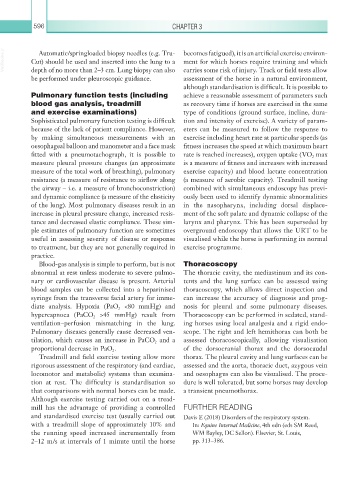Page 621 - Equine Clinical Medicine, Surgery and Reproduction, 2nd Edition
P. 621
596 CHAPTER 3
VetBooks.ir Cut) should be used and inserted into the lung to a becomes fatigued), it is an artificial exercise environ-
Automatic/springloaded biopsy needles (e.g. Tru-
ment for which horses require training and which
depth of no more than 2–3 cm. Lung biopsy can also
be performed under pleuroscopic guidance. carries some risk of injury. Track or field tests allow
assessment of the horse in a natural environment,
although standardisation is difficult. It is possible to
Pulmonary function tests (including achieve a reasonable assessment of parameters such
blood gas analysis, treadmill as recovery time if horses are exercised in the same
and exercise examinations) type of conditions (ground surface, incline, dura-
Sophisticated pulmonary function testing is difficult tion and intensity of exercise). A variety of param-
because of the lack of patient compliance. However, eters can be measured to follow the response to
by making simultaneous measurements with an exercise including heart rate at particular speeds (as
oesophageal balloon and manometer and a face mask fitness increases the speed at which maximum heart
fitted with a pneumotachograph, it is possible to rate is reached increases), oxygen uptake (VO max
2
measure pleural pressure changes (an approximate is a measure of fitness and increases with increased
measure of the total work of breathing), pulmonary exercise capacity) and blood lactate concentration
resistance (a measure of resistance to airflow along (a measure of aerobic capacity). Treadmill testing
the airway – i.e. a measure of bronchoconstriction) combined with simultaneous endoscopy has previ-
and dynamic compliance (a measure of the elasticity ously been used to identify dynamic abnormalities
of the lung). Most pulmonary diseases result in an in the nasopharynx, including dorsal displace-
increase in pleural pressure change, increased resis- ment of the soft palate and dynamic collapse of the
tance and decreased elastic compliance. These sim- larynx and pharynx. This has been superseded by
ple estimates of pulmonary function are sometimes overground endoscopy that allows the URT to be
useful in assessing severity of disease or response visualised while the horse is performing its normal
to treatment, but they are not generally required in exercise programme.
practice.
Blood-gas analysis is simple to perform, but is not Thoracoscopy
abnormal at rest unless moderate to severe pulmo- The thoracic cavity, the mediastinum and its con-
nary or cardiovascular disease is present. Arterial tents and the lung surface can be assessed using
blood samples can be collected into a heparinised thoracoscopy, which allows direct inspection and
syringe from the transverse facial artery for imme- can increase the accuracy of diagnosis and prog-
diate analysis. Hypoxia (PaO <80 mmHg) and nosis for pleural and some pulmonary diseases.
2
hypercapnoea (PaCO >45 mmHg) result from Thoracoscopy can be performed in sedated, stand-
2
ventilation– perfusion mismatching in the lung. ing horses using local analgesia and a rigid endo-
Pulmonary diseases generally cause decreased ven- scope. The right and left hemithorax can both be
tilation, which causes an increase in PaCO and a assessed thoracoscopically, allowing visualisation
2
proportional decrease in PaO . of the dorsocranial thorax and the dorsocaudal
2
Treadmill and field exercise testing allow more thorax. The pleural cavity and lung surfaces can be
rigorous assessment of the respiratory (and cardiac, assessed and the aorta, thoracic duct, azygous vein
locomotor and metabolic) systems than examina- and oesophagus can also be visualised. The proce-
tion at rest. The difficulty is standardisation so dure is well tolerated, but some horses may develop
that comparisons with normal horses can be made. a transient pneumothorax.
Although exercise testing carried out on a tread-
mill has the advantage of providing a controlled FURTHER READING
and standardised exercise test (usually carried out Davis E (2018) Disorders of the respiratory system.
with a treadmill slope of approximately 10% and In: Equine Internal Medicine, 4th edn (eds SM Reed,
the running speed increased incrementally from WM Bayley, DC Sellon). Elsevier, St. Louis,
2–12 m/s at intervals of 1 minute until the horse pp. 313–386.

